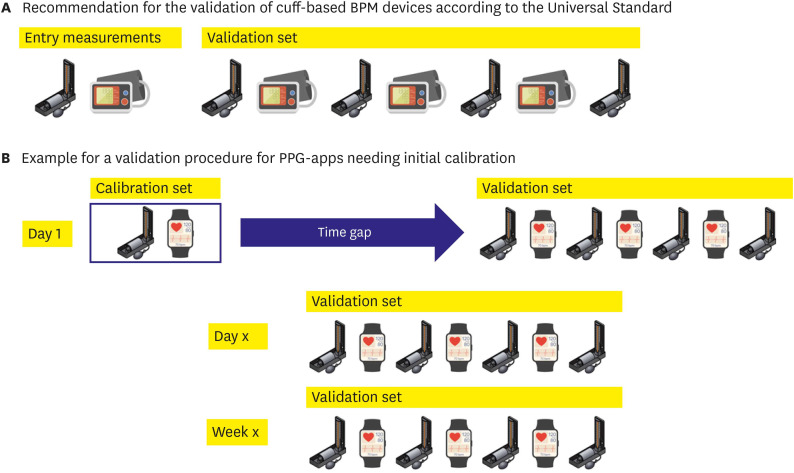1. Stergiou GS, O’Brien E, Myers M, et al. STRIDE BP international initiative for accurate blood pressure measurement: Systematic review of published validation studies of blood pressure measuring devices. J Clin Hypertens (Greenwich). 2019; 21:1616–1622. PMID:
31654494.

2. Vischer AS, Burkard T. Principles of blood pressure measurement - Current techniques, office vs ambulatory blood pressure measurement. Adv Exp Med Biol. 2017; 956:85–96. PMID:
27417699.

3. Williams B, Mancia G, Spiering W, et al. 2018 ESC/ESH guidelines for the management of arterial hypertension. Eur Heart J. 2018; 39:3021–3104. PMID:
30165516.
4. Vaidyanathan S, Jermany J, Yeh C, Bizot MN, Camisasca R. Aliskiren, a novel orally effective renin inhibitor, exhibits similar pharmacokinetics and pharmacodynamics in Japanese and Caucasian subjects. Br J Clin Pharmacol. 2006; 62:690–698. PMID:
17118124.

6. Picone DS, Deshpande RA, Schultz MG, et al. Nonvalidated home blood pressure devices dominate the online marketplace in Australia: major implications for cardiovascular risk management. Hypertension. 2020; 75:1593–1599. PMID:
32275193.

7. Dey J, Gaurav A, Tiwari VN. InstaBP: cuff-less blood pressure monitoring on smartphone using single PPG sensor. Annu Int Conf IEEE Eng Med Biol Soc. 2018; 2018:5002–5005. PMID:
30441464.

8. Matsumura K, Rolfe P, Toda S, Yamakoshi T. Cuffless blood pressure estimation using only a smartphone. Sci Rep. 2018; 8:7298. PMID:
29740088.

9. Chandrasekhar A, Natarajan K, Yavarimanesh M, Mukkamala R. An iPhone application for blood pressure monitoring via the oscillometric finger pressing method. Sci Rep. 2018; 8:13136. PMID:
30177793.

10. Luo H, Yang D, Barszczyk A, et al. Smartphone-based blood pressure measurement using transdermal optical imaging technology. Circ Cardiovasc Imaging. 2019; 12:e008857. PMID:
31382766.

11. Vybornova A, Polychronopoulou E, Wurzner-Ghajarzadeh A, Fallet S, Sola J, Wuerzner G. Blood pressure from the optical Aktiia Bracelet: a 1-month validation study using an extended ISO81060-2 protocol adapted for a cuffless wrist device. Blood Press Monit. 2021; 26:305–311. PMID:
33675592.
12. Association for the Advancement of Medical Instrumentation (US). American National Standards Institute. International Organization for Standardization. AAMI/ANSI/ISO 81060-2:2013, Non-invasive Sphygmomanometers - Part 2: Clinical Investigation of Automated Measurement Type. Arlington (VA): Association for the Advancement of Medical Instrumentation.
13. Plante TB, Urrea B, MacFarlane ZT, et al. Validation of the instant blood pressure smartphone App. JAMA Intern Med. 2016; 176:700–702. PMID:
26938174.

14. Raichle CJ, Eckstein J, Lapaire O, et al. Performance of a blood pressure smartphone App in pregnant women: the iPARR trial (iPhone App compared with standard RR measurement). Hypertension. 2018; 71:1164–1169. PMID:
29632098.

15. Xing X, Ma Z, Zhang M, Zhou Y, Dong W, Song M. An unobtrusive and calibration-free blood pressure estimation method using photoplethysmography and biometrics. Sci Rep. 2019; 9:8611. PMID:
31197243.

16. Stergiou GS, Palatini P, Asmar R, et al. Recommendations and practical guidance for performing and reporting validation studies according to the universal standard for the validation of blood pressure measuring devices by the Association for the Advancement of Medical Instrumentation/European Society of Hypertension/International Organization for Standardization (AAMI/ESH/ISO). J Hypertens. 2019; 37:459–466. PMID:
30702492.

17. Stergiou GS, Alpert B, Mieke S, et al. A universal standard for the validation of blood pressure measuring devices: Association for the Advancement of Medical Instrumentation/European Society of Hypertension/International Organization for Standardization (AAMI/ESH/ISO) Collaboration Statement. J Hypertens. 2018; 36:472–478. PMID:
29384983.

18. Padwal R. Cuffless blood pressure measurement: How did accuracy become an afterthought? Am J Hypertens. 2019; 32:807–809. PMID:
31053838.

19. Institute of Electrical and Electronics Engineers (IEEE) Engineering in Medicine and Biology Society. IEEE Std 1708-2014. IEEE Standard for Wearable, Cuffless Blood Pressure Measuring Devices. New York (NY): Institute of Electrical and Electronics Engineers, Inc.;2014.
20. Parati G, Stergiou GS, Asmar R, et al. European Society of Hypertension guidelines for blood pressure monitoring at home: a summary report of the Second International Consensus Conference on Home Blood Pressure Monitoring. J Hypertens. 2008; 26:1505–1526. PMID:
18622223.

21. Bilo G, Zorzi C, Ochoa Munera JE, Torlasco C, Giuli V, Parati G. Validation of the Somnotouch-NIBP noninvasive continuous blood pressure monitor according to the European Society of Hypertension International Protocol revision 2010. Blood Press Monit. 2015; 20:291–294. PMID:
25932885.

22. Krisai P, Vischer AS, Kilian L, Meienberg A, Mayr M, Burkard T. Accuracy of 24-hour ambulatory blood pressure monitoring by a novel cuffless device in clinical practice. Heart. 2019; 105:399–405. PMID:
30228251.

23. Socrates T, Krisai P, Vischer AS, Meienberg A, Mayr M, Burkard T. Improved agreement and diagnostic accuracy of a cuffless 24-h blood pressure measurement device in clinical practice. Sci Rep. 2021; 11:1143. PMID:
33441915.

24. Diaz KM, Tanner RM, Falzon L, et al. Visit-to-visit variability of blood pressure and cardiovascular disease and all-cause mortality: a systematic review and meta-analysis. Hypertension. 2014; 64:965–982. PMID:
25069669.

25. Jeon YW, Kim HC. Factors associated with awareness, treatment, and control rate of hypertension among Korean young adults aged 30–49 years. Korean Circ J. 2020; 50:1077–1091. PMID:
32975054.

26. Lee HY, Oh GC, Sohn IS, et al. Suboptimal management status of younger hypertensive population in Korea. Korean Circ J. 2021; 51:598–606. PMID:
34085433.






 PDF
PDF Citation
Citation Print
Print



 XML Download
XML Download